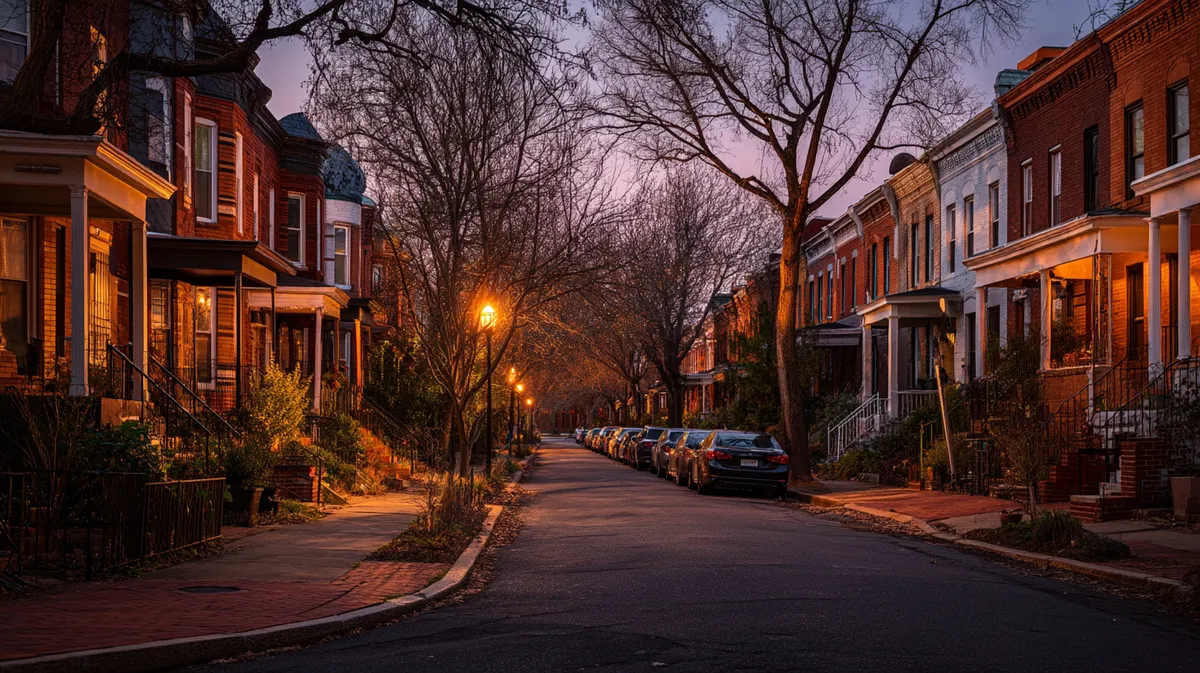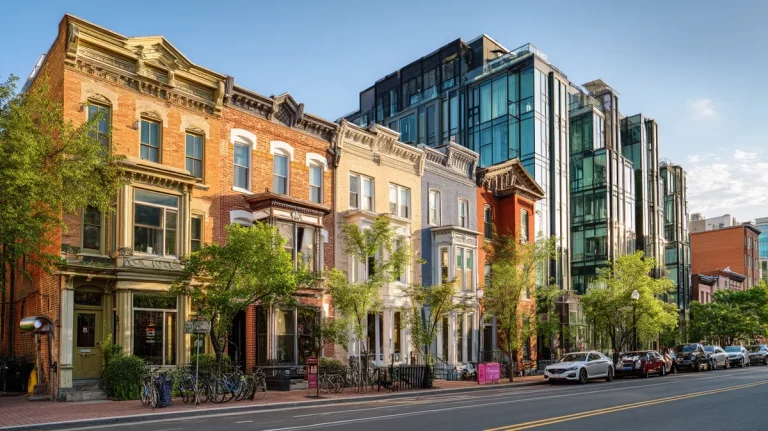Living in the Shaw neighborhood of Washington, DC, feels a bit like straddling two versions of the city at once.
On one hand, you’ve got that buzzy string of bars and restaurants wrapped around U Street and 7th, a scene that keeps the sidewalks thick with young professionals and late-night concertgoers. On the other hand, you’ll still catch vestiges of the area’s storied jazz era, row-house blocks where residents wave from painted porches, and weekly farmers markets on Rhode Island Ave.
Because those seemingly opposite energies rub shoulders day in and day out, it’s natural to wonder how safe Shaw really is, especially if you’re weighing homes for sale in Shaw and debating a move.
Below, we’ll sift through the actual crime data, compare Shaw with nearby neighborhoods, and talk about what it feels like on the ground so you can decide whether the Shaw neighborhood suits your comfort level.
Overview of Shaw
Introduction to Living in Shaw, DC
Ask ten residents of Shaw and you’ll hear the same thing: the place punches above its weight when it comes to energy. Music spills from basement venues along U Street, and new coffee shops slot right next to century-old row homes. That mix gives the Shaw neighborhood a magnetic pull, especially for a lot of young professionals who want walkability without paying Georgetown prices.
In real-life conversations, most residents of Shaw say they never felt unsafe on their own block.
People typically describe crime in Shaw as situational rather than constant menace—crowd-driven around bars and restaurants on weekend nights, quieter on side streets where families grill on tiny patios.
Geographical Location
Shaw sits smack in the center of Washington, DC, wedged between Mount Vernon Square to the south, LeDroit Park to the north, and Downtown DC just a few minutes’ bike ride away. Rhode Island Avenue slices through the eastern edge, while Florida Avenue marks the northern rim.
That central position means you can reach nearly any part of the city’s neighborhood grid by Metro or a quick bus hop, but it also means Shaw sees the most incidents of property theft that target commuters who cut through.
Cost of Living in Shaw
Housing isn’t cheap.
AreaVibes pegs the cost of living in Shaw at 67 percent above the national average and about 12 percent above Washington’s city average, with home prices nearly triple the typical U.S. figure.
That said, if you’re shopping homes for sale in Shaw, you’ll find a range from petite condos behind 9:30 Club to restored Victorians on 6th Street.
Because the neighborhood is dense, daily expenses such as groceries, gym memberships, and a happy-hour pint tend to track with District of Columbia norms rather than tourist-zone markups.
Shaw Crime Breakdown
Property Crime
According to CrimeGrade, there are 49.5 incidents per 1,000 residents in a standard year.
Residents face about a 1-in-20 chance of a break-in, package theft, or car prowling, rising to 1 in 17 near the busiest bar blocks. Projected tangible losses for 2025 hover around $4.4 million, about $330 per resident.
Crime maps mark the safest areas in Shaw in green toward the northeast; red areas cluster near U Street and Rhode Island Ave, where parking lots and tourist foot traffic converge.
Violent Crime
The violent crime rate shows 9.4 incidents per 1,000 residents, placing Shaw in the 13th percentile for safety nationwide.
Green pockets on the Shaw crime map hug quieter residential lanes; red areas stay concentrated around late-night entertainment strips.
Other Crime
Drug offenses, vandalism, and fraud do occur, although they are reported less consistently. Citywide dashboards suggest around 18 incidents per 1,000 residents, fluctuating by season and special events.
Most locals treat these problems as nuisances rather than deal-breakers, noting they seldom affect day-to-day routines.
Trends in Shaw, Washington, DC Crime Rates
Washington Post reporting shows violent crime rose in 2024 compared with 2022. Property crime followed suit, ticking up about 23 percent according to AreaVibes.
Still, long-term charts trace a downward slope since the 1990s peak, and police say more cameras and brighter lighting should push numbers lower over the next few years.
Comparing Crime Rates: Shaw vs. Nearby Cities
Comparison of Shaw Crime Rates with the District of Columbia
Citywide crime rates hover 128 percent above the national average. But even against that backdrop, Shaw is higher than other neighborhoods when you drill into per-capita numbers.
Take violent crime: Shaw’s 9.4 per 1,000 handily beats the District’s 10.47, yet property crime balloons to 49.5 per 1,000 versus the city’s 41.6. Put differently, the crime rate in Shaw lands you a 1-in-12 chance of becoming a victim of crime in a standard year—noticeably riskier than the 1-in-20 city average.
Interpreting the Shaw statistics gets easier when you remember that rates are measured per resident; a dense row of apartments around 9th Street will naturally show more calls for service than leafy single-family enclaves west of 5th.
Safety Measures and Resources
Chance of Being a Victim of Crime in Shaw
With 49.5 property crimes and 9.4 violent crimes per 1,000 residents, the chance of being a victim hovers near one in twelve each year.
Risk shrinks in green-shaded safe areas east of 8th Street and climbs in red areas where bars and restaurants cluster. Because crime rates are measured per resident, a block that fills with tourists can look far worse on paper than it feels on a Tuesday morning.
Role of the Metropolitan Police Department
PSA 308 officers concentrate patrols around nightlife corridors on weekends, while community walks focus on broken lights and alley dumping that invite higher crime. MPD also pilots live cameras near scooter corrals to deter quick hit-and-run thefts.
Community Safety Initiatives
Shaw Main Streets promotes porch-light campaigns, neighborhood text alerts, and youth sports nights. Residents say these grassroots steps build the “eyes on the street” vibe that helps them feel safe even when statistics signal caution.
Living in Shaw: Is it a Safe Place to Live?
Long-timers paint a balanced picture. Crime rates in Shaw sit above the national average, yet most residents say daily routines such as dog walks at dawn, late cones from Ice Cream Jubilee, feel uneventful.
Trouble clusters around U Street’s bars after midnight; walk two blocks east and things quiet down fast. Dashboards echo that block-by-block split: red zones near nightlife, green pockets on calmer residential lanes. Parents at Seaton Elementary report few worries, and young professionals still pack restaurants and bars.
Bottom line? Feeling safe here depends less on the headline numbers and more on sticking to lit routes, locking bikes, and using the same street smarts you’d bring to any lively city neighborhood.
Shaw Safety FAQs
While bars and restaurants naturally pull in pickpockets and the occasional assault, crime in Shaw varies by area and by hour. Weekday mornings and residential side streets typically see far fewer incidents than the red areas near Metro exits and the 7th Street bar strip, so the picture changes once nightlife crowds thin out and morning commuters replace them.
Adams Morgan posts crime rates about fifty percent above the national average, whereas Shaw’s overall index runs closer to three times the national average.
Both neighborhoods, but less safe than suburban pockets west of Rock Creek, deal with similar nightlife energy, yet Shaw ranks slightly higher for property offenses, while Adams Morgan edges ahead on late-night assaults.
Crime maps and statistics show a modest uptick in vehicle break-ins and theft along Rhode Island Ave because surface parking and quick highway access tempt thieves.
Even so, residents in a standard year cut that risk by using secured lots, installing dash cams, and keeping valuables out of sight, and many say they never felt unsafe walking the corridor during daylight.
Simple moves work: lock bikes indoors, keep porch lights burning, and walk home with a friend after midnight. Many Shaw residents join neighborhood message boards that alert users in real time when crimes are reported, and home security firms offer discounted monitoring packages. These collective habits show up in crime data as a gradual decline in opportunistic thefts on well-lit blocks.
Statistically, Shaw is higher than other neighborhoods with similar populations for property crime, yet serious violent crimes involving children remain rare.
Parents note active PTAs, freshly renovated playgrounds, and quick MPD response times as reasons they feel safe, citing that the type and severity of reported incidents seldom involve school routes or afternoon play areas.


